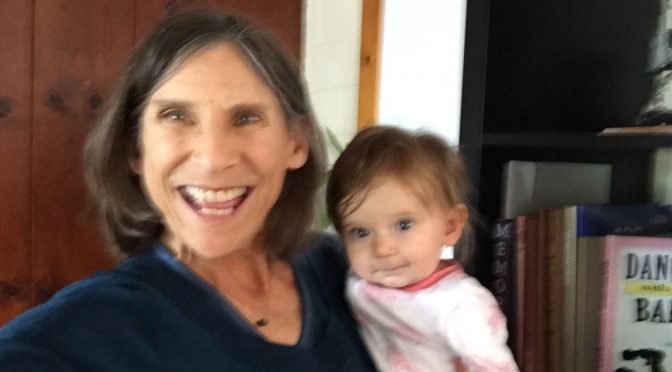In September of 2016, I ecstatically added to the burgeoning class of baby-boomers becoming grandparents. There are 70 million Americans a year joining the ranks. Caregiving my granddaughter during the workweek is a bit of heaven, and much comfort to her parents. It’s also longevity enhancing for me: the Berlin Aging Study found that grandparents who provided non-custodial childcare died at a rate 37% lower than for grandparents who did not provide childcare, and even non-grandparents benefited if they did caregiving .
When proximity allows and kin are willing, pitching in is a godsend for parents and baby. If not, early childhood development advocates stress the importance of a continuity of caregivers during the first year, and ideally for three. Also important is consistency in behavioral expectations of the baby. As author of Dancing With Your Baby, it’s no surprise my baby boy grew up to be a dad happy to dance with his baby.
Daily dancing (and singing) to music together is my granddaughter’s favorite activity. She’s been exposed to a wide variety of music from around the world. At 8 months, she most enjoys facing outward taking in all her surroundings, and flying like a bird exciting her balance and proprioceptive senses. And always over-the-heart slow dancing before bottle time and naps. Even as we stop on our strolls, her in a snuggly baby carrier, she giggles with enthusiasm as I rock back and forth and sing in her ear. She’s quite a rhythmic clapper too, grooving to the beat. Knowing all the mutual benefits, grandma couldn’t be more delighted.
Recently I had the pleasure of meeting fellow advocates of dancing with your baby, Meeshi and Amber Anjali. They are the founders of GroovaRoo Dance™ (aptly named), offering babywearing dance classes and world-wide teacher training. You may have seen their video of a group of men dancing with their baby that went viral (see below). They recently were on a California tour promoting their method of babywearing dance workshops, along with Baby TULA, featuring Tula’s brand new Free-To-Grow baby carrier.
Meeshi and Amber’s aim is to “create a safe, sacred and soulful dance experience for you and your baby.” Taking their classes is a chance to engage in a supportive community, so therapeutic for all. To ensure this sense of belonging, the GroovaRoo method incorporates a tender touch–at the end of the class they sing to each other and their babies during the cool-down dance and stretches. As they say: “it’s important to sing together to feel more connected to each other as a tribe.”
Research by D. Fancourt and R. Perkins at Imperial College London showed that daily singing to babies is associated with fewer symptoms of maternal postnatal depression and anxiety. It also enhanced maternal wellbeing and self-esteem. Likewise, it facilitated mother-infant bonding, along with positive changes in arousal and responsiveness of the baby.
As for the specific impact of dancing together, Laura K. Cirelli’s studies found that: “moving in synchrony with others encourages prosocial behavior. Adults who walk, sing, or tap together are later more likely to be cooperative, helpful, and rate each other as likeable.” Their work showed that this held true for 14-month-old infants as well. The same researchers subsequently investigated music’s role in interpersonal synchrony to influence a baby’s pro-social behavior. They concluded that, “the presence of music may act as a mood regulator or distractor to help keep infants happy and allow them to fully experience the effects of synchronous movement.”
Developmental psychologists Dana Shai and Peter Fonagy propose that secure attachment be seen as “an embodied—in the body—phenomenon” and suggest that early relational experiences be conceptualized as “embodied attachment.” They argue that parent and infant have an implicit dynamic, interactive, kinaesthetic experience. As the parent embodies and mentalizes, they form attachment representations. On an unconscious level, such mentalizing acts and guides social behavior, becoming internalized in the infant’s body on every level, “motor, autonomic, hormonal, and sensory,” building the “interpersonal sense of self.” This occurs when baby is cared for in a way that sees them as capable of intending and mentally having subjective agency, and that their actions were attended to and regulated by the parental figure.
May parents, grandparents, and all caregivers be inspired to embrace song, dance, and music into their daily life with their baby–a vital way to thrive throughout the life-cycle.
References:
Associations between singing to babies and symptoms of postnatal depression, wellbeing, self-esteem and mother-infant bond. Fancourt, D., and R. Perkins. Public Health 145 (2017): 149-152. http://bit.ly/2qZWHxu
Beyond Words: Parental Embodied Mentalizing and the Parent-Infant Dance. Dana Shai and Herzliya Peter Fonagy. http://bit.ly/2rKehXC
Caregiving within and beyond the family is associated with lower mortality for the caregiver: A prospective study. Sonja Hilbrand, , David A. Coal, Denis Gerstorf, Ralph Hertwig Evolution and Human Behavior Volume 38, Issue 3, May 2017, Pages 397–403. http://bit.ly/2honXO9
Effects of Interpersonal Movement Synchrony on Infant Helping Behaviors–Is Music Necessary? Laura K. Cirelli, Stephanie J. Wan, Christina Spinelli, Laurel J. Trainor. Music Perception: An Interdisciplinary Journal, Vol. 34 No. 3, February 2017; (pp. 319-326) DOI: 10.1525/mp.2017.34.3.319 http://mp.ucpress.edu/content/34/3/319
The Grandparent Boom. AARP Bulletin, May 2017, Vol. 58, No. 4
Grandparent Power: Wisdom, Experience and Perspective – An Intergenerational Mental Health Resource. Michelle Cleary RN, PhD, Christine Handley RN, RPN, BAppSci & Rachel Kornhaber RN, PhD. Issues in Mental Health Nursing Vol. 38 , Iss. 2,2017 http://bit.ly/2qn5VW6
GroovaRoo Dance™ America’s Orignial Babywearing Dance Crew http://groovaroo.com
https://www.facebook.com/groovaroodance/
https://www.instagram.com/groovaroodance/
